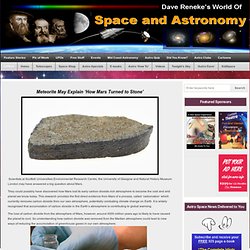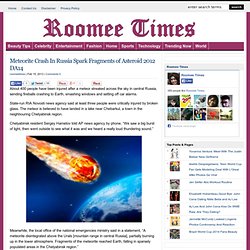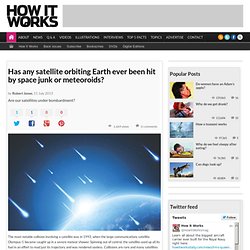

UFO Destroys Meteor Before Hitting Planet Earth. METEOR HITS EARTH! San Jose 10-17-2012. Meteor Hits Russia 2013 - Best Footage Collection. Meteorite hits moon in largest lunar impact ever recorded - video. Breaking News: New Found Asteroid 2014 DH6 Very Close Encounter With Earth. The Birth of Planet Earth. Could An Asteroid Impact Event Cause Mass Extinction on Earth ? 2014 Meteor Superstorms Are Expected Huge Comets Target Earth and Mars WTH Is Going On? First Asteroid of 2014 Hits Earth Over Atlantic Ocean. If A Meteor Hits Earth. 15 Strange Things About Outer Space. 15 Strange Things About Outer Space We all had to memorize that cute mnemonic solar system device in grade school that taught us the order of the planets.

Some of us even had Milky Way place-mats or mobiles. But for most of us, the outer space education ended there. (Sorry guys: “Star Trek” and Star Wars don’t count.) Maybe that’s because space feels too distant to ever be relevant to our day-to-day routines. But maybe it’s time to start paying attention to space again. 1. These mysterious starlike objects shine from the outermost limits of the universe, helping scientists learn about the earliest stages of existence. 2.
You may have learned that some planets in the solar system are gaseous, but did you know that Saturn, that blinged-out planet with all the rings, could float in water? 3. Here on Earth, liquids tend to flow downward. 4. Tidal effects cause the moon to move about 3.8 cm away from Earth every year. 5. 6. 7. 8. All human beings are about two inches taller in space. 9. 10.
Meteorite May Explain ‘How Mars Turned to Stone’ Scientists at Scottish Universities Environmental Research Centre, the University of Glasgow and Natural History Museum London may have answered a big question about Mars.

They could possibly have discovered how Mars lost its early carbon dioxide-rich atmosphere to become the cold and arid planet we know today. This research provides the first direct evidence from Mars of a process, called ‘carbonation’ which currently removes carbon dioxide from our own atmosphere, potentially combating climate change on Earth. It is widely recognised that accumulation of carbon dioxide in the Earth’s atmosphere is contributing to global warming. The loss of carbon dioxide from the atmosphere of Mars, however, around 4000 million years ago is likely to have caused the planet to cool. So understanding how carbon dioxide was removed from the Martian atmosphere could lead to new ways of reducing the accumulation of greenhouse gases in our own atmosphere.
Why? Because Science. If you’ve seen the movies Deep Impact, Armageddon, Asteroid or The Land Before Time, chances are you’ve entertained the idea: what would I do if a meteor was on a collision course with Earth?

What would happen? Would NASA send out a space shuttle to intercept the galactic gate-crasher? Could Iran be coaxed into donating its alleged caches of nuclear warheads to the task of obliterating the Earth-bound asteroid? What’s the post-apocalyptic weather like? Meteorite Crash In Russia Spark Fragments of Asteroid 2012 DA14 - Roomee Times : Roomee Times. About 400 people have been injured after a meteor streaked across the sky in central Russia, sending fireballs crashing to Earth, smashing windows and setting off car alarms.

State-run RIA Novosti news agency said at least three people were critically injured by broken glass. The meteor is believed to have landed in a lake near Chebarkul, a town in the neighbouring Chelyabinsk region. Chelyabinsk resident Sergey Hametov told AP news agency by phone, “We saw a big burst of light, then went outside to see what it was and we heard a really loud thundering sound.” Meanwhile, the local office of the national emergencies ministry said in a statement, “A meteorite disintegrated above the Urals [mountain range in central Russia], partially burning up in the lower atmosphere.
Fragments of the meteorite reached Earth, falling in sparsely populated areas in the Chelyabinsk region.” Chelyabinsk residents reported shaking ground, windows being shattered and car alarms being set off during the shower. Top 10 Space Weapons. Meteoroid Bombardment May Have Made Earth More Habitable, Says Study. Large bombardments of meteoroids approximately four billion years ago could have helped to make the early Earth and Mars more habitable for life by modifying their atmospheres, suggests the results of a new study.

When a meteoroid from space enters a planet’s atmosphere, extreme heat causes some of the minerals and organic matter on its outer crust to be released as water and carbon dioxide (as a meteor burning up in the atmosphere) before it breaks up and hits the ground (and becomes a meteorite). Researchers suggest the delivery of this water could have made Earth’s and Mars’ atmospheres wetter. The release of the greenhouse gas carbon dioxide could have trapped more energy from sunlight to make Earth and Mars warm enough to sustain liquid oceans.
The researchers used a new technique called pyrolysis-FTIR, which uses electricity to rapidly heat the fragments at a rate of 20,000 degrees Celsius per second, and they then measured the gases released. Has any satellite orbiting Earth ever been hit by space junk or meteoroids? The most notable collision involving a satellite was in 1993, when the large communications satellite Olympus-1 became caught up in a severe meteor shower.

Spinning out of control, the satellite used up all its fuel in an effort to read just its trajectory and was rendered useless. Collisions are rare and many satellites now have tracking systems in place to shift their course when potential collisions are imminent. The biggest danger for satellites, however, is not from large asteroids, but from the millions of tiny leftover pieces of defunct satellites. At less than one centimetre (0.4 inches) in diameter they are far too small for us to track, and can travel at speeds of 35,400 kilometres (22,000 miles) per hour – so fast that even a fleck of paint could cause devastation to a satellite. Answered by Rik Sargent. March 2008. REAL SPACE DANGER meteors.